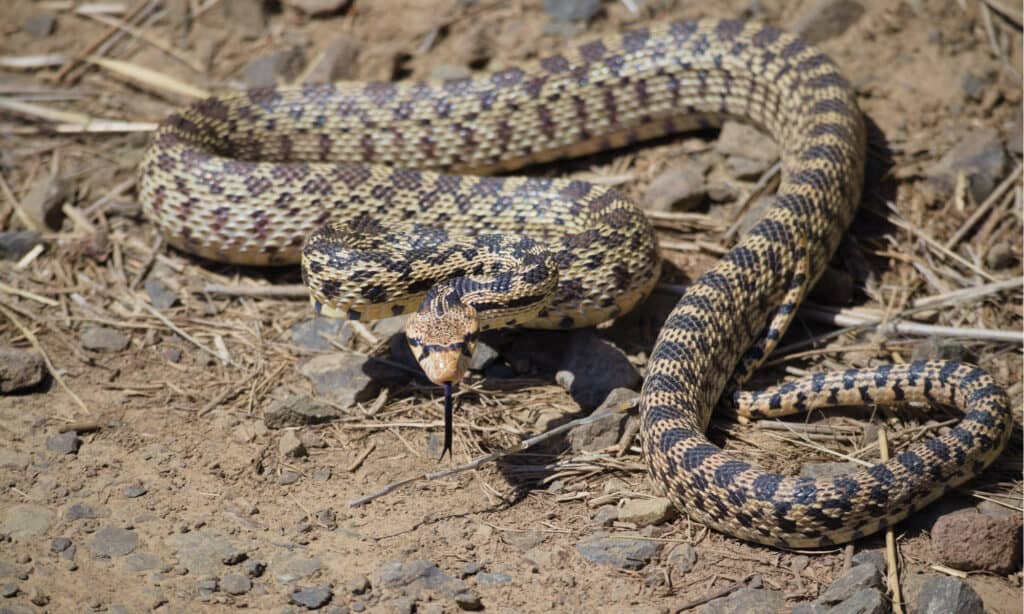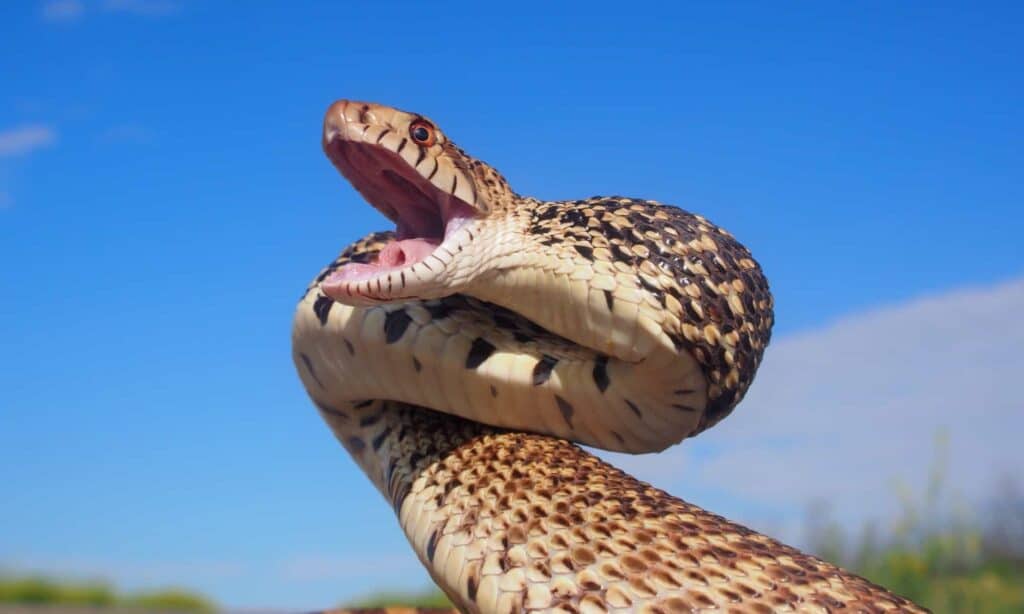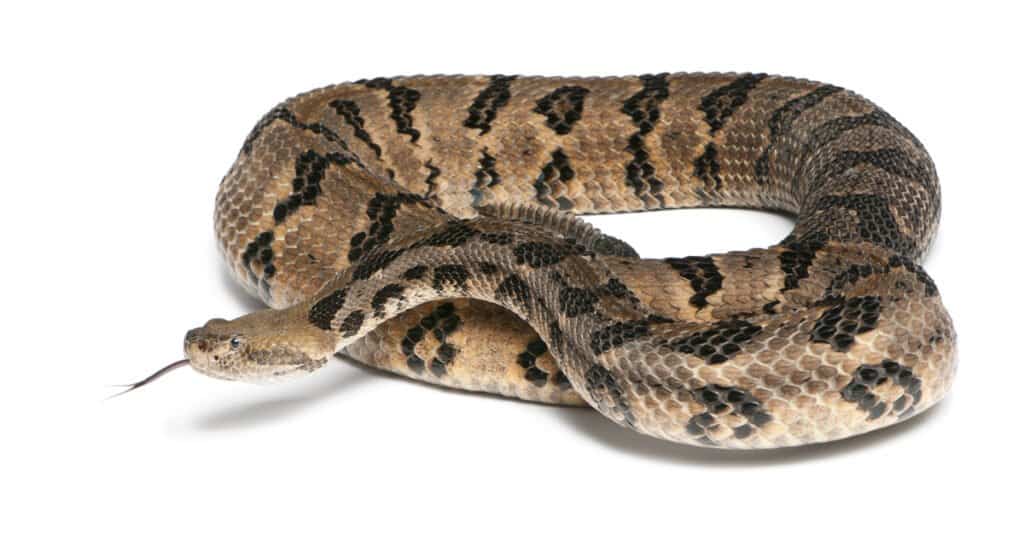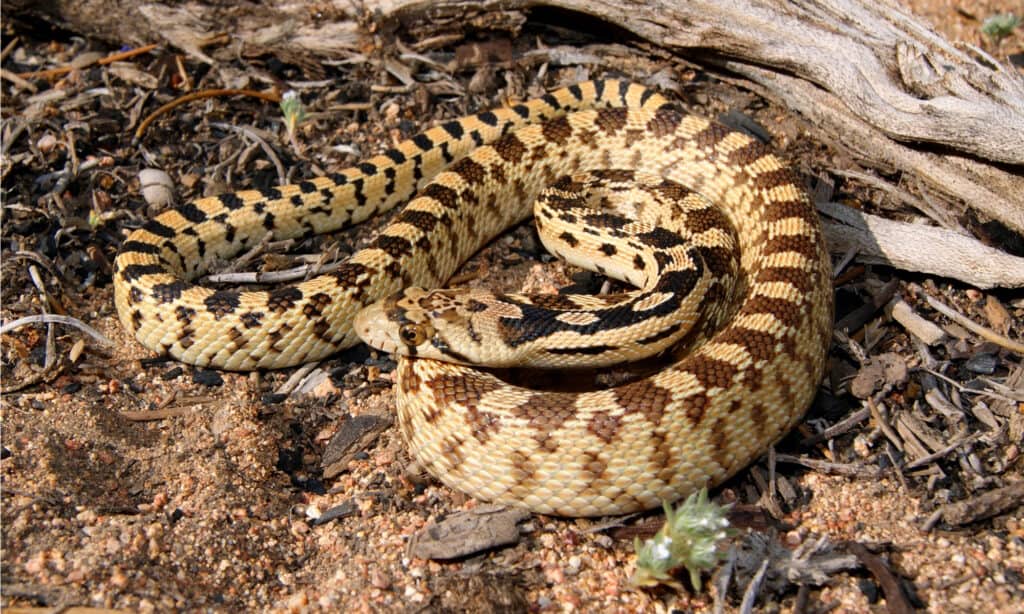Bullsnakes are the largest snakes in Nebraska. Some can get to be 6 feet long or more! The good news about bullsnakes is they are not harmful to humans; they are not venomous and actually help keep the rodent population under control. Bullsnakes typically keep to themselves but there are reports of people finding them in their bathtubs, couches and even in their beds — yikes! Let’s find out about bullsnakes in Nebraska!
What is a bullsnake?

Bullsnakes are the largest snake in Nebraska averaging 4-6 feet long.
©GoodFocused/Shutterstock.com
Bullsnakes belong to the Colubridae family which has around 1,760 species of snakes and makes up 2/3 of the snake populations. Sometimes bullsnakes are called gopher snakes and are a subspecies of the gopher snake. They are a relatively large snake with a medium to heavy build and length of 4-6 feet (with some being recorded even longer!). Most weigh between 2 ½ – 3 ½ pounds. They have a tan base color and dark brown markings. Near the tail it looks as if the bullsnake has vertical brown stripes along the length of the tail.
Bullsnakes are not venomous, but they can bite. They have a habit of mimicking rattlesnakes when they feel threatened. They can flatten their head, raise it off the ground and brush their tail against loose rocks to make a rattling noise. Sometimes bullsnakes will make an odd grunting or hissing noise to ward off predators (including humans).
Where do bullsnakes live?
Bullsnakes do live in Nebraska, but they are also spread out through much of the western U.S. They can be found in North Dakota, South Dakota, Colorado, Kansas, Texas, Montana, New Mexico, Missouri, Oklahoma, Minnesota, Iowa, Wyoming, Wisconsin, Illinois, and Indiana.
Their habitat is prairies, grasslands, woodland and urban/suburban yards and gardens. Bullsnakes are burrowing snakes and will often take over the burrows of other animals like gophers, ground squirrels, et cetera.
Where do bullsnakes live in Nebraska?

Bullsnakes in Nebraska prefer sandy areas and grasslands.
©Christopher Joe Brown/Shutterstock.com
Bullsnakes can be found throughout Nebraska, they prefer sandy prairies and grasslands. The ones that live in western Nebraska tend to be a little lighter in color than the ones that live in the eastern half of the state.
What do bullsnakes eat in Nebraska?

Farmers actually like bullsnakes because they take care of problem rodents like mice,
rats
, rabbits and weasels.
©Markparker1983/Shutterstock.com
Bullsnake are actually favored by farmers because they eat many of the harmful rodents that live on the farm. They will kill and eat mice, rats, rabbits, pocket gophers, weasels, and minks. Bullsnakes also eat bird eggs like hens and barn swallows and the smaller birds if they can catch them. They are not afraid to take on prey larger than you think. Some can consume animals that weigh as much as a pound.
Bullsnakes in the News:
“Snake cuts power in southwest Omaha, Papillion”
In late June of 2021, the Omaha Public Power District figured out what caused a power outage in southwest Omaha. A large bull snake had crawled into the equipment area causing the outage. The repair crew was able to get the power up and running by noon.
“Nebraska woman finds ‘angry’ snake in bed”
Just to clarify, the snake wasn’t angry until the woman who found it started throwing her shoe at it. The snake was probably quite comfortable before that. The woman who lived near Bluestem Lake, came home on a Thursday evening to find the snake camped out in her bed. Bluestem Lake is about 20 miles SE of Lincoln, NE. She called the Lancaster County Sheriff’s office and Deputy Zieg removed the snake, later identified as a bullsnake, from the woman’s home. The report mentioned that bullsnakes will sometimes sneak into people’s homes if they leave their garage doors open, tip of the day!
“More snakes seem to be slithering around”
In the summer of 2013 there were a lot more sightings of bullsnakes. More were found dead along the side of the road in Lincoln County, NE. Experts thought it could be from the drought the summer before which may have lowered the rodent population. This would make the snakes have to travel more to find food.
Are there any venomous snakes in Nebraska?
Yes. Of the 29 species of snakes in the state, 4 of them are venomous.

Timber Rattlesnakes
can look similar to bullsnakes, but Timber rattlers are VENOMOUS!
©Eric Isselee/Shutterstock.com
- Timber rattlesnake: largest rattlesnake in Nebraska, 44-60 inches long, looks similar to a bullsnake, only found in the extreme southeast corner of the state, listed as a threatened species in Nebraska
- Prairie rattlesnake: lighter in color than bullsnakes and have a greenish hue, 35-45 inches long, lives in prairie dog burrows, only in the western half of Nebraska
- Copperhead: tan to copper in color with large brown splotches, the head is triangle in shape and copper in color, 28-35 inches long, only found in Richardson County to the east and Gage County
- Massasauga: light gray to dark brown with large dark brown spots, 28-36 inches long, lives near water like lakes, rivers, wetlands, only found in the southeast corner of the state, nicknamed the “swamp rattler”, protected in Nebraska considered a threatened species
How many people in Nebraska get bitten by snakes?
According to the Nebraska Regional Poison Center they receive around 20 calls a year about native snakebites and 1-2 non-native venomous snakebites. Those bitten by non-native snakes are typically private collectors, not random cases of the public. If you are hiking in any of the State Parks in Nebraska it is safest to stay on the trails to avoid startling a snake. Most snakes are not aggressive and only bite when they feel threatened or are handled.
How many people in the U.S. get bitten by snakes?
There are an estimated 45,000 snake bites a year in the U.S. with 7,000-8,000 of those being from venomous snakes. Of all of those there is an average of 4-5 deaths per year in the U.S. Here in the U.S. most medical facilities have access to antivenom which can be used to counter the toxic effects of the snake venom.
Are bullsnakes in Nebraska dangerous?

Bullsnakes may be surprising if you find one in your bed but they are not dangerous or harmful to humans.
©Matt Jeppson/Shutterstock.com
No, bullsnakes are not harmful to humans. They can bite but they only have a row of tiny teeth that don’t leave much of a mark. Bullsnakes are not venomous.
Up Next
- The 5 Best Places to Camp in Nebraska
- The Longest Biking Trail in Nebraska
- Discover the 9 Largest Animals in Nebraska
The photo featured at the top of this post is © rawaccess/Shutterstock.com
Discover the "Monster" Snake 5X Bigger than an Anaconda
Every day A-Z Animals sends out some of the most incredible facts in the world from our free newsletter. Want to discover the 10 most beautiful snakes in the world, a "snake island" where you're never more than 3 feet from danger, or a "monster" snake 5X larger than an anaconda? Then sign up right now and you'll start receiving our daily newsletter absolutely free.
FAQs (Frequently Asked Questions)
Are bull snakes dangerous?
No, bullsnakes are not harmful to humans. They can bite but they only have a row of tiny teeth that don’t leave much of a mark. Bullsnakes are not venomous.
Where do bull snakes live in Nebraska?
Bullsnakes can be found throughout Nebraska, they prefer sandy prairies and grasslands. The ones that live in western Nebraska tend to be a little lighter in color than the ones that live in the eastern half of the state.
Thank you for reading! Have some feedback for us? Contact the AZ Animals editorial team.






